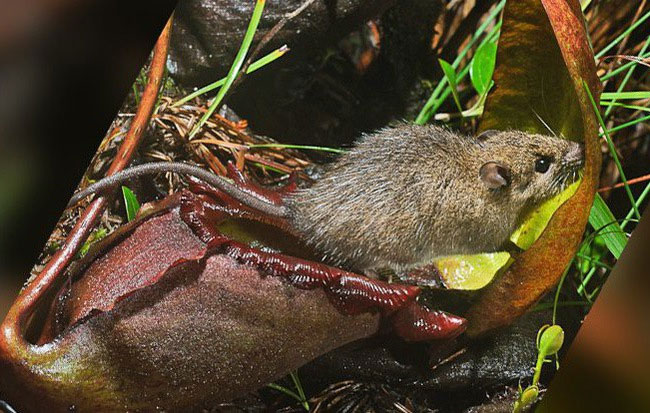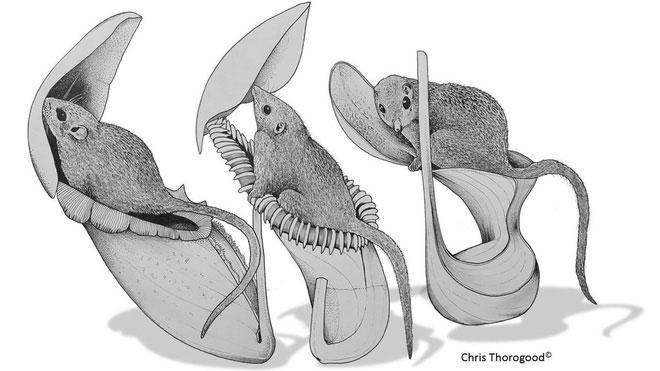'Tragedy' the world's largest carnivorous life: Death becomes ... public toilet
You know, the trees in this world not only enjoy peace, but also meat-eating plants. Among them, the largest predatory tree is Nepenthes rajah warmth tree .
This is an indigenous tree of Mount Kinabalu , near Borneo (Malaysia). They look like giant pineapple trees, with a height of up to 2.5m. On the trunk of the tree, there are buds that look like warm water, only things are deadly traps.
Their teapots are only about 41cm long, but contain up to 4l of digestive juices. As noted by science, they often hunt insects (flies, ants, spiders .), and also digest quite "big" mice.
But the life of the pitcher tree is not only pink. One day, the scientific community blurted out when it realized that the plant also turned itself into a . public toilet for a native mouse named Tupaia montana - which is also their prey.

Their teapots are only about 41cm long, but contain up to 4l of digestive juices
The deadly structure of the warm lid suddenly becomes . toilet seat with a perfect design for the mouse. They all sat down, relaxed and confided, and left and left a kettle there for waste.

The warm lid suddenly became . toilet seat with a perfect design for the mouse.
However, recently, scientists have finally understood the cause for the tragedy of the warm-lid tree. It turned out to be the evolutionary mechanism of this plant . They have turned themselves into toilets for rats , then live on the digestion of their faeces and urine.
According to Chris Thorogood, a biologist at Oxford University, the warm-cap plant is a very interesting research object. They can produce nearly 4l of digestive fluids, while continuously producing bile in very large quantities. Thorogood said it took 150 years for science to understand the true purpose of this honey.
They are used to attract mice, seduce them to eat and "settle" right into the pot.
In fact, the pitcher plants N. rajahis in this study grew in a region with very few mosquitoes, and therefore they are forced to follow the above path of extremely unsanitary evolution. The amount of honey produced is to lure the mice to stay longer, and increase their chances of "going to the toilet" .
In addition, the design of the warm lid allows mouse droppings to fall straight to the bottom, which contains the most digestible fluids and resolves them quickly.

The design of the warm lid allows mouse droppings to fall straight to the bottom.
According to Thorogood, the evolutionary mechanism of the pitcher plant is not too strange. Another species of fly fly, N. hemsleyana, also has a similar relationship with bats. They create shelters for bats, in exchange for bats that will . release food to the trees.
Talking about the Tupaia montana rats, they also use some other predatory species such as N. lowii and N. macrophylla as public toilets. But of these, only N. lowii is a species that loses its ability to hunt. And our giant pitcher tree and N. macrophylla live on both nutrients: catching prey and rat droppings.
"These warm lid plants have evolved to store more water," Thorogood said.
It sounds tragic, but scientists say the rat droppings are not so bad. They contain a small amount of nutrients, bringing very good nitrogen and phosphorus with the plants. So that is the mechanism of evolution in the form of mutual benefits.
Still, there are still some questions to clarify. For example, how do rats know that the pitcher plant is ready to "eat"? In response to this question, the hypothesis is that the tree will have its own signaling way. For example, N. lowii can turn the leaf surface darker and brighter, signaling mice to know when to "vent".
- Explore the world of warm lid trees
- Thorel warm lid reappeared in Vietnam after more than 100 years
- Learn the facts startled to the toilet makes everyone surprised
- The 11 most unique public toilets in the world
- Unexpected truth about public toilets
- Intelligent urinating: no need to go to the toilet, have self-cleaning system
- Don't put up paper when you go to the public restroom, it's useless too
- Toilet public also know face recognition in China
- Extremely hidden carnivorous plants
- Mistake when using toilet paper so many people suffer without knowing
- Why is the public toilet door designed with space above and below?
- Japanese public toilets often have folded paper rolls like this, the reason is ...
- Why are toilet seats in public toilets shaped U-shaped?
- The real reason for the phenomenon of seeing other worlds?
 Why do potatoes have eyes?
Why do potatoes have eyes? Tomatoes were once considered 'poisonous' for 200 years
Tomatoes were once considered 'poisonous' for 200 years Detecting microscopic parasites on human face
Detecting microscopic parasites on human face Ghost orchid - expensive flower but the tree does not have a leaf
Ghost orchid - expensive flower but the tree does not have a leaf